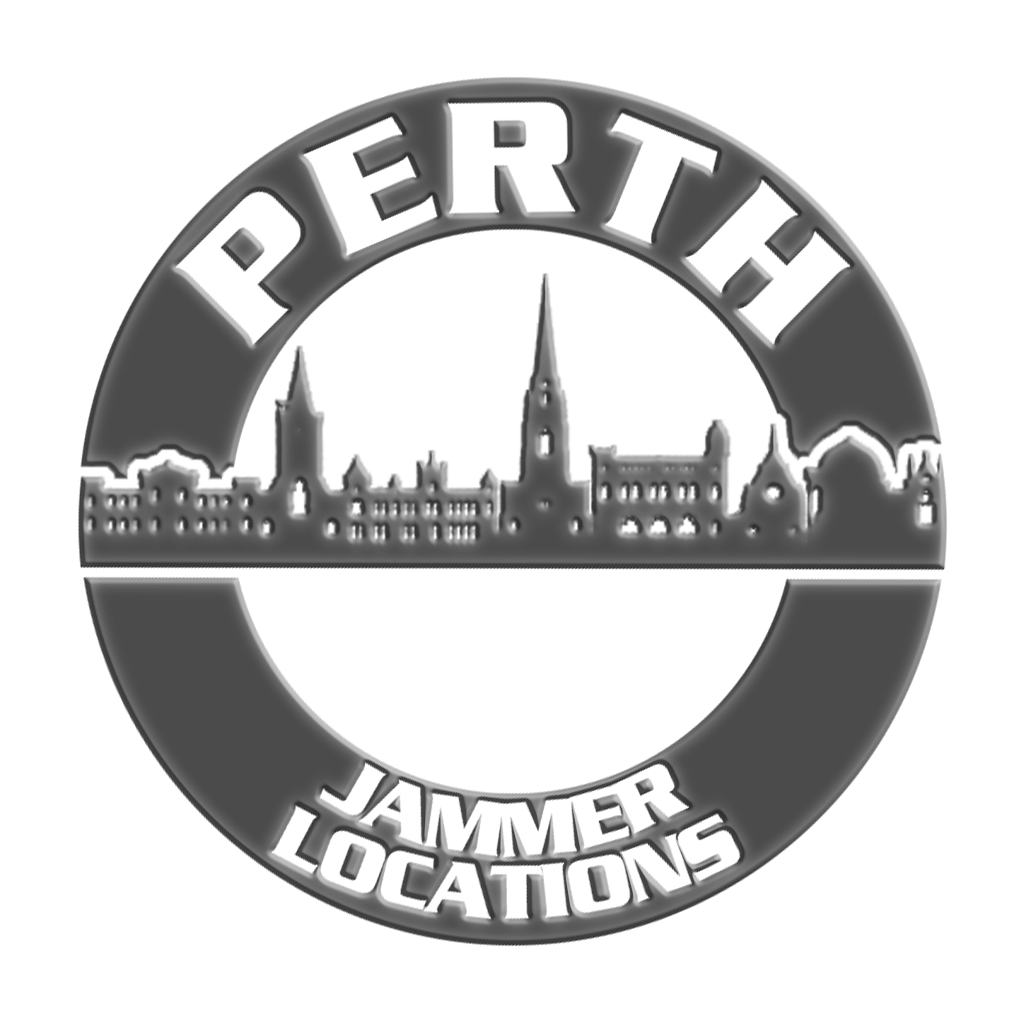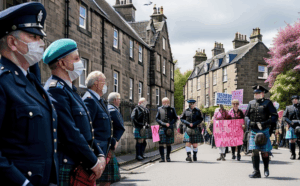Perth city centre recently witnessed its latest large-scale demonstration concerning immigration, drawing over 100 participants to express their views. The event, spearheaded by a group identified as ‘Pink Ladies’ and supported by ‘Perth’s Peaceful Protest,’ marked a significant moment in the ongoing local discourse surrounding asylum seekers residing in the city’s hotels.
This particular march, held on a Saturday, was the sixth such gathering to take place in Perth since August, highlighting persistent community interest and concern. It notably represented the inaugural public procession led under the ‘Pink Ladies’ banner, a name also associated with similar demonstrations at hotels in other parts of the UK. However, direct organisational links between the Perth group and these external entities remain unspecified.
In anticipation of the demonstration, Perth and Kinross Council had previously communicated that no official public procession licence had been sought by the organisers. This advisory aimed to inform the public about the event’s regulatory status within the local area, underscoring adherence to established guidelines for public assemblies.
The backdrop to these protests involves approximately 190 asylum seekers currently accommodated in two hotels within Perth. Despite repeated assurances from Perth and Kinross Council that there are no immediate plans to significantly increase these numbers – specifically refuting claims of an additional 250 individuals – the issue continues to fuel discussions and public gatherings.
Earlier insights from a local publication revealed the personal experiences of three asylum seekers living in Perth, who shared their earnest desire to integrate and contribute positively to the city, even amidst the prevailing atmosphere of hostility. Their testimonies offered a poignant contrast to the public sentiment expressed by some protesters, illustrating the human dimension of the debate. Events Unfold in Perth City Centre
On the day of the march, the North Inch served as the starting point for the assembly, which included women adorned in pink attire, some accompanied by children, alongside larger contingents of men displaying Saltires and Union flags. Prior to their departure, law enforcement officials, through a megaphone, issued a clear warning to the assembled groups regarding the potential for arrest should they proceed with an unlicensed procession. This official admonition was met with vocal dissent from some attendees, who responded with exclamations of displeasure. However, a local business figure, Lee Stronach, known for his involvement in previous organisational efforts for such protests, intervened to de-escalate the situation, urging participants to remain calm.
Mr. Stronach then guided the procession through several prominent arteries of the city, including Tay Street, High Street, South Street, and Leonard Street, drawing attention across various public spaces. Voices from the March and Public Reaction
A 25-year-old female participant, who chose to remain anonymous, articulated her motivation for joining the march. She emphasized that the protest was driven by concerns for ‘the safety of women, kids and possibly men,’ unequivocally rejecting any association with far-right or racist ideologies. She highlighted a perceived shortage of resources for existing local populations, questioning the rationale behind accommodating more ‘undocumented people’ when local services are already stretched. Her statement reflected a sentiment that Perth, in her view, is undergoing undesirable changes, leading to anxieties about the safety of girls within the community. ‘I’m mixed race, and my family is like the United Nations. It’s not about skin colour,’ she stated, reinforcing her position.
Throughout the march, protesters engaged in chants critical of both law enforcement and the local authority, and were observed shouting phrases like ‘Send them home.’ They also directed audible disapproval towards journalists covering the event. Public response along the route was varied; some motorists expressed solidarity by honking their horns, while other members of the public openly conveyed their disagreement, leading to at least one minor physical altercation. Despite the visible tensions, Police Scotland later confirmed that no arrests were made in connection with the demonstration, indicating their assessment that the procession largely adhered to legal boundaries by remaining on pavements. Council Leader’s Stance and Call for Dialogue
Simultaneously, a counter-demonstration organised by ‘Perth Against Racism’ convened outside the Radisson Blu Hotel, one of the accommodations housing asylum seekers. Notably, the newly appointed leader of Perth and Kinross Council, Eric Drysdale, joined the ranks of the counter-protesters, signifying the local authority’s stance on the matter.
Speaking to the press, Mr. Drysdale acknowledged the constitutional right to protest but underscored his belief that any such actions should be directed towards critiquing the systemic issues that lead to prolonged stays for asylum seekers, rather than targeting the individuals themselves. He conveyed that law enforcement had informed him that the marchers did not breach legal parameters as long as they confined themselves to pedestrian areas. Mr. Drysdale stressed the imperative for the UK Government to urgently devise effective solutions to what he termed the ‘logjam’ in the asylum system, hoping that such measures would contribute to the de-escalation of public tensions in Perth.
While expressing concern over the current situation, he reiterated the council’s limited capacity to intervene as long as protests remain within legal bounds. Despite the complexities, Council Leader Drysdale extended an offer for private dialogue, stating, ‘If a representative of the protesters wishes to meet with me privately, I don’t have an issue with that.’ This gesture aimed to open lines of communication amidst a deeply polarised local debate, seeking a path towards understanding and resolution within the community.
This particular march, held on a Saturday, was the sixth such gathering to take place in Perth since August, highlighting persistent community interest and concern. It notably represented the inaugural public procession led under the ‘Pink Ladies’ banner, a name also associated with similar demonstrations at hotels in other parts of the UK. However, direct organisational links between the Perth group and these external entities remain unspecified.
In anticipation of the demonstration, Perth and Kinross Council had previously communicated that no official public procession licence had been sought by the organisers. This advisory aimed to inform the public about the event’s regulatory status within the local area, underscoring adherence to established guidelines for public assemblies.
The backdrop to these protests involves approximately 190 asylum seekers currently accommodated in two hotels within Perth. Despite repeated assurances from Perth and Kinross Council that there are no immediate plans to significantly increase these numbers – specifically refuting claims of an additional 250 individuals – the issue continues to fuel discussions and public gatherings.
Earlier insights from a local publication revealed the personal experiences of three asylum seekers living in Perth, who shared their earnest desire to integrate and contribute positively to the city, even amidst the prevailing atmosphere of hostility. Their testimonies offered a poignant contrast to the public sentiment expressed by some protesters, illustrating the human dimension of the debate. Events Unfold in Perth City Centre
On the day of the march, the North Inch served as the starting point for the assembly, which included women adorned in pink attire, some accompanied by children, alongside larger contingents of men displaying Saltires and Union flags. Prior to their departure, law enforcement officials, through a megaphone, issued a clear warning to the assembled groups regarding the potential for arrest should they proceed with an unlicensed procession. This official admonition was met with vocal dissent from some attendees, who responded with exclamations of displeasure. However, a local business figure, Lee Stronach, known for his involvement in previous organisational efforts for such protests, intervened to de-escalate the situation, urging participants to remain calm.
Mr. Stronach then guided the procession through several prominent arteries of the city, including Tay Street, High Street, South Street, and Leonard Street, drawing attention across various public spaces. Voices from the March and Public Reaction
A 25-year-old female participant, who chose to remain anonymous, articulated her motivation for joining the march. She emphasized that the protest was driven by concerns for ‘the safety of women, kids and possibly men,’ unequivocally rejecting any association with far-right or racist ideologies. She highlighted a perceived shortage of resources for existing local populations, questioning the rationale behind accommodating more ‘undocumented people’ when local services are already stretched. Her statement reflected a sentiment that Perth, in her view, is undergoing undesirable changes, leading to anxieties about the safety of girls within the community. ‘I’m mixed race, and my family is like the United Nations. It’s not about skin colour,’ she stated, reinforcing her position.
Throughout the march, protesters engaged in chants critical of both law enforcement and the local authority, and were observed shouting phrases like ‘Send them home.’ They also directed audible disapproval towards journalists covering the event. Public response along the route was varied; some motorists expressed solidarity by honking their horns, while other members of the public openly conveyed their disagreement, leading to at least one minor physical altercation. Despite the visible tensions, Police Scotland later confirmed that no arrests were made in connection with the demonstration, indicating their assessment that the procession largely adhered to legal boundaries by remaining on pavements. Council Leader’s Stance and Call for Dialogue
Simultaneously, a counter-demonstration organised by ‘Perth Against Racism’ convened outside the Radisson Blu Hotel, one of the accommodations housing asylum seekers. Notably, the newly appointed leader of Perth and Kinross Council, Eric Drysdale, joined the ranks of the counter-protesters, signifying the local authority’s stance on the matter.
Speaking to the press, Mr. Drysdale acknowledged the constitutional right to protest but underscored his belief that any such actions should be directed towards critiquing the systemic issues that lead to prolonged stays for asylum seekers, rather than targeting the individuals themselves. He conveyed that law enforcement had informed him that the marchers did not breach legal parameters as long as they confined themselves to pedestrian areas. Mr. Drysdale stressed the imperative for the UK Government to urgently devise effective solutions to what he termed the ‘logjam’ in the asylum system, hoping that such measures would contribute to the de-escalation of public tensions in Perth.
While expressing concern over the current situation, he reiterated the council’s limited capacity to intervene as long as protests remain within legal bounds. Despite the complexities, Council Leader Drysdale extended an offer for private dialogue, stating, ‘If a representative of the protesters wishes to meet with me privately, I don’t have an issue with that.’ This gesture aimed to open lines of communication amidst a deeply polarised local debate, seeking a path towards understanding and resolution within the community.


